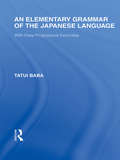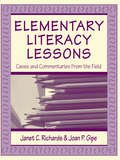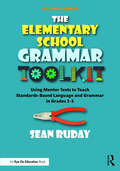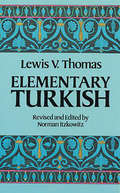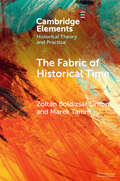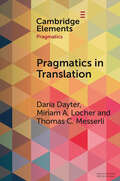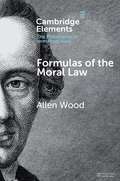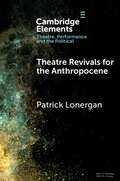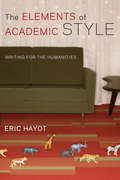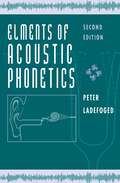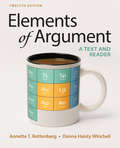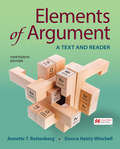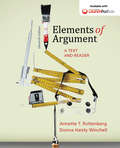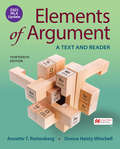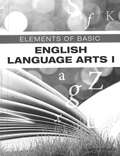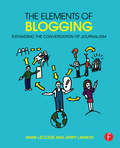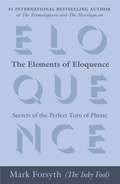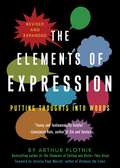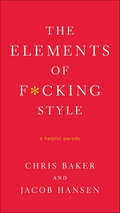- Table View
- List View
An Elementary Grammar of Old Icelandic (Routledge Library Editions: Linguistics)
by Helen MacMillan BuckhurstThe first available Elementary Grammar of Old Icelandic in the English language, this book is primarily intended for the beginner. To this end, the greater part of the space is devoted to a detailed treatment of the inflexions and of such points of syntax as are likely to cause difficulties.
An Elementary Grammar of the Japanese Language: With Easy Progressive Exercises (Routledge Library Editions: Japan)
by Tatui BabaWhen originally published in 1873 one of the aims was to protest against an idea that the Japanese language was very imperfect, and therefore it should be exterminated! The second was to give a general idea of the Japanese language as it is spoken.
Elementary Literacy Lessons: Cases and Commentaries From the Field
by Janet C. Richards Joan P. GipeInnovative and practical, this text helps prepare teachers to support the literacy learning needs of all children in grades K-6, including academically, linguistically, and culturally diverse students. It features original teaching cases written by preservice teachers enrolled in field-based reading/language arts methods courses, accompanied by commentaries written by experienced teacher educators and skilled classroom teachers. High-interest content and a reader-friendly format encourage critical and reflective thinking about topics important to effective literacy instruction. By promoting reflection about case issues, the text helps prepare future teachers to respond to teaching narratives presented on the practical applications section of the PRAXIS II, an examination required in most states for teacher licensure. The authentic cases candidly and poignantly describe preservice teachers' plans, problems, hopes, disappointments, dilemmas, and reflective thinking as they address the multilayered complexities and ambiguities associated with learning to teach reading and language arts in elementary classrooms. These teaching stories reveal glimpses of literacy instruction and allow us to enter real classrooms and experience the wide varieties of situations that reading/language arts teachers encounter daily. Although the cases are grouped according to specific dimensions of literacy theory and pedagogy, just as in real classrooms, other issues are woven through each case as well. The commentaries provide scholarly, and sometimes contrasting, perspectives and approaches through which readers might consider the issues presented in the cases. The commentaries represent only particular perspectives, but readers are encouraged to explore and consider as many perspectives and issues as possible regarding each case. Each chapter includes helpfulpedagogical features: * New or critical concepts and terms listed at the beginning of each chapter alert readers to what might be unfamiliar vocabulary. * Applications and Reflections pages help readers take an active part in analyzing, documenting, and talking about the particular issues portrayed in the case narratives. Using the questions on these pages, the cases and accompanying commentaries can be read and discussed as a whole class activity, in small collaborative groups, or by individuals. The questions can also be used by readers to guide their own case writing initiatives. * Margin References direct readers to correlated readings for the strategies and parallel concepts mentioned in the cases and commentaries. Suggested readings can be discussed within the format of literacy study groups. * Annotated Bibliographies at the end of each chapter help readers construct more in-depth knowledge for the instructional strategies and activities discussed in the teaching cases. The cases, commentaries, and pedagogical features in this distinctive text provide rich opportunities for readers to discover what they need to know and how they need to think in order to teach reading and language arts effectively and successfully.
The Elementary School Grammar Toolkit: Using Mentor Texts to Teach Standards-Based Language and Grammar in Grades 3–5
by Sean RudayTeaching grammar can be overwhelming and is often an overlooked part of effective instruction. The Elementary School Grammar Toolkit to the rescue! Now in its second edition, this comprehensive guide makes grammar instruction fun and meaningful. You will learn how to… • Teach grammar in a practical way to help students grow as readers and writers by presenting each grammar rule as a useful writing tool. • Use mentor texts—excerpts from great literature—to help students understand grammar in action. • Promote metacognition along the way so that students become responsible for their own learning. • Implement innovative instructional strategies and tools aligned with Common Core and other state standards. Throughout the book, you'll find step-by-step recommendations for teaching each of the grammar tools to help students meet the Common Core State Standards and other state language standards for grades three to five, plus classroom snapshots that show you the tools in action, handy templates that you can use in the classroom, and new tips for extra support at the end of every chapter. New! The second edition features revised classroom snapshots and exemplars to showcase successful practices, new visuals, more free charts and activities, and new "Bonus Tips for Support" in each chapter, with extra practices and strategies to use with students who need extra support. The expanded, free annotated bibliography is updated to include contemporary, high-quality children’s and young adult literature and gives examples of key grammatical concepts found in each work. These resources are available as supplemental downloads on our website.
Elementary Syntactic Structures
by Cedric BoeckxMost syntacticians, no matter their theoretical persuasion, agree that features (types or categories) are the most important units of analysis. Within Chomskyan generative grammar, the importance of features has grown steadily and within minimalism, it can be said that everything depends on features. They are obstacles in any interdisciplinary investigation concerning the nature of language and it is hard to imagine a syntactic description that does not explore them. For the first time, this book turns grammar upside down and proposes a new model of syntax that is better suited for interdisciplinary interactions, and shows how syntax can proceed free of lexical influence. The empirical domain examined is vast, and all the fundamental units and properties of syntax (categories, parameters, Last Resort, labelling, and hierarchies) are rethought. Opening up new avenues of investigation, this book will be invaluable to researchers and students in syntactic theory, and linguistics more broadly.
Elementary Turkish (Dover Language Guides)
by Lewis ThomasTurkish is the primary language of some thirty million people. Anyone concerned with current social, political, and cultural developments in Turkey knows that a practical understanding of the basic patterns of modern Turkish is an invaluable skill that until now has been difficult to attain without extensive training.This superb grammar and exercise text, used successfully for years in Princeton University, enables English-speaking students — in and out of the classroom — to gain a quick and thorough understanding of modern Turkish. In a carefully arranged sequence of 23 lessons, Lewis V. Thomas, late Professor of Oriental Studies at Princeton, presents thorough coverage that allows the student to begin to use the basic patterns of modern Turkish without time-consuming and expensive private instruction.The method of instruction was devised after an extensive analysis of results in Princeton classrooms, and relies on exercises at the end of each lesson to test the student's grasp of the material. Beginning with the alphabet and numbers, Professor Thomas offers clear, concise coverage of articles, adjectives and nouns, common infinitives, personal pronouns, and elementary verbs. As the student's comprehension of basic elements develops, further lessons deal with more complicated subjects such as the possessive construction, past general verbs, postpositions, the partitive, progressive verb forms, and abbreviating verb forms. A complete Turkish-English glossary translates new vocabulary occurring in the exercises.Norman Itzkowitz, Professor of Near Eastern Studies at Princeton University, has skillfully made the necessary revisions and additions to complete Professor Thomas' work. For anyone who needs to communicate in this important and influential language, Professor Thomas' proven course, now in an inexpensive paperback edition, is the most effective method available.
Elements in Historical Theory and Practice: The Fabric of Historical Time (Elements In Historical Theory And Practice Ser.)
by Zoltán Boldizsár Simon Marek TammElements in Pragmatics: Mediality, Participation And Relational Work (Elements In Pragmatics Ser.)
by Daria Dayter Miriam A. Locher Thomas C. MesserliElements in the Philosophy of Immanuel Kant: Formulas of the Moral Law (Elements In The Philosophy Of Immanuel Kant Series)
by Allen WoodThis Element defends a reading of Kant's formulas of the moral law in Groundwork of the Metaphysics of Morals. It disputes a long tradition concerning what the first formula (Universal Law/Law of Nature) attempts to do. <P><P>The Element also expounds the Formulas of Humanity, Autonomy and the Realm of Ends, arguing that it is only the Formula of Humanity from which Kant derives general duties, and that it is only the third formula (Autonomy/Realm of Ends) that represents a complete and definitive statement of the moral principle as Kant derives it in the Groundwork. The Element also disputes the claim that the various formulas are 'equivalent', arguing that this claim is either false or else nonsensical because it is grounded on a false premise about what Kant thinks a moral principle is for.
Elements in Theatre, Performance and the Political: Theatre Revivals for the Anthropocene (Elements In Theatre, Performance And The Political Ser.)
by Patrick LonerganThe Elements of Academic Style: Writing for the Humanities
by Eric HayotEric Hayot teaches graduate students and faculty in literary and cultural studies how to think and write like a professional scholar. From granular concerns, such as sentence structure and grammar, to big-picture issues, such as adhering to genre patterns for successful research and publishing and developing productive and rewarding writing habits, Hayot helps ambitious students, newly minted Ph.D.'s, and established professors shape their work and develop their voices.Hayot does more than explain the techniques of academic writing. He aims to adjust the writer's perspective, encouraging scholars to think of themselves as makers and doers of important work. Scholarly writing can be frustrating and exhausting, yet also satisfying and crucial, and Hayot weaves these experiences, including his own trials and tribulations, into an ethos for scholars to draw on as they write. Combining psychological support with practical suggestions for composing introductions and conclusions, developing a schedule for writing, using notes and citations, and structuring paragraphs and essays, this guide to the elements of academic style does its part to rejuvenate scholarship and writing in the humanities.
The Elements of Academic Style: Writing for the Humanities
by Eric HayotEric Hayot teaches graduate students and faculty in literary and cultural studies how to think and write like a professional scholar. From granular concerns, such as sentence structure and grammar, to big-picture issues, such as adhering to genre patterns for successful research and publishing and developing productive and rewarding writing habits, Hayot helps ambitious students, newly minted Ph.D.'s, and established professors shape their work and develop their voices.Hayot does more than explain the techniques of academic writing. He aims to adjust the writer's perspective, encouraging scholars to think of themselves as makers and doers of important work. Scholarly writing can be frustrating and exhausting, yet also satisfying and crucial, and Hayot weaves these experiences, including his own trials and tribulations, into an ethos for scholars to draw on as they write. Combining psychological support with practical suggestions for composing introductions and conclusions, developing a schedule for writing, using notes and citations, and structuring paragraphs and essays, this guide to the elements of academic style does its part to rejuvenate scholarship and writing in the humanities.
Elements of Acoustic Phonetics
by Peter LadefogedThis revised and expanded edition of a classic textbook provides a concise introduction to basic concepts of acoustics and digital speech processing that are important to linguists, phoneticians, and speech scientists. The second edition includes four new chapters that cover new experimental techniques in acoustic phonetics made possible by the use of computers. Assuming no background in physics or mathematics, Ladefoged explains concepts that must be understood in using modern laboratory techniques for acoustic analysis, including resonances of the vocal tract and the relation of formants to different cavities; digital speech processing and computer storage of sound waves; and Fourier analysis and Linear Predictive Coding, the equations used most frequently in the analysis of speech sounds. Incorporating recent developments in our knowledge of the nature of speech, Ladefoged also updates the original edition's discussion of the basic properties of sound waves; variations in loudness, pitch, and quality of speech sounds; wave analysis; and the hearing and production of speech. Like its predecessor, this edition of Elements of Acoustic Phonetics will serve as an invaluable textbook and reference for students and practitioners of linguistics and speech science, and for anyone who wants to understand the physics of speech.
The Elements of Alternate Style: Essays on Writing and Revision
by Wendy BishopElements of Alternate Style contributes to a better understanding of the writing process in general and the stylistic options available to every serious writer. It demonstrates how by teaching alternate and traditional styles in tandem, by focusing on revision as invention, we can help students become newly engaged with their texts-even "school writing. " In this edited collection, successful classroom instructors explore and apply these ideas, drawing from composition pedagogy, creative writing technique, and critical theory. The six essays in Part I delineate an initial classroom sequence. . The authors ask writers to try writing exercises and to reconsider how they have constructed essays in the past-how they might reconstruct them today by looking and looking again, by fracturing and creating double voices, by reconsidering the place of research. Part II pushes these explorations further in five essays that contend that writing is about taking risks, trying (sometimes failing), learning from exploration, from play, from radical twists and turns. Part III engages even broader issues of identity, technology, correctness, and editing. Elements of Alternate Style is a powerful, liberating resource that validates innovative writing instruction and offers a rich array of voices and techniques.
Elements of Argument
by Annette T. Rottenberg Donna Haisty WinchellElements of Argument teaches students how to approach, develop, and defend arguments one element at a time. This comprehensive, accessible text carefully scaffolds argument for students, explaining approaches to argumentation, (including Aristotelian, Toulmin, and Rogerian models as well as Stasis Theory questions), critical reading, and argument analysis. The major components of argumentation--claims, support, assumptions, logic--are explained in depth, and a robust research section shows students how to find, incorporate, and build on existing arguments. This Twelfth Edition has also been updated with more sourced readings than ever before, further reinforcing the importance of research and synthesis. Finally, the anthology includes debates and casebooks on unsettled current issues as well as timeless, classic arguments, making Elements of Argument a comprehensive resource for the argument classroom.
Elements of Argument: A Text and Reader
by Annette T. Rottenberg Donna Haisty WinchellWith Elements of Argument you get two books in one: an argument text and a reader focused on the issues you care about. In addition you�ll find lots of support to help you understand the components of argument in order to build your own compelling essays. And if you�re writing a research paper, you�ll appreciate the guidance on evaluating sources for bias and the sample essays that model effective use of digital sources.
Elements of Argument
by Donna Haisty Winchell Annette T. RottenbergPACKAGE THIS TITLE WITH OUR 2016 MLA SUPPLEMENT, Documenting Sources in MLA Style (package ISBN-13: 9781319084639). Get the most recent updates on MLA citation in a convenient, 40-page resource based on The MLA Handbook, 8th Edition, with plenty of models. Browse our catalog or contact your representative for a full listing of updated titles and packages, or to request a custom ISBN. Elements of Argument combines a thorough argument text on critical thinking, reading, writing, and research with an extensive reader on both current and timeless controversial issues. It presents everything students need to analyze, research, and write arguments. Elements of Argument covers Toulmin, Aristotelian, and Rogerian models of argument and has been thoroughly updated with current selections students will want to read. With three-quarters of the readings new to this edition (and with additional multimodal selections available online), expanded coverage of key rhetorical issues, reorganized research chapters, and a fresh design, Elements of Argument is a truly flexible classroom resource. An e-book is available at half the price of the print book. Our newest set of online materials, LaunchPad Solo, provides all the key tools and course-specific content that you need to teach your class. Get all our great course-specific materials in one fully customizable space online; then assign and mix our resources with yours. To package LaunchPad Solo free with Elements of Argument, Eleventh Edition, use 978-1-319-01079-9.
Elements of Argument with 2021 MLA Update: A Text and Reader
by Annette T. Rottenberg Donna Haisty WinchellThis ebook has been updated to provide you with the latest guidance on documenting sources in MLA style and follows the guidelines set forth in the MLA Handbook, 9th edition (April 2021).With Elements of Argument you get two books in one: an argument text and a reader focused on the issues you care about. In addition you’ll find lots of support to help you understand the components of argument in order to build your own compelling essays. And if you’re writing a research paper, you’ll appreciate the guidance on evaluating sources for bias and the sample essays that model effective use of digital sources.
Elements of Basic: English Language Arts I
by Nancy NicholsElements Of Basic English Language Arts I
The Elements of Blogging: Expanding the Conversation of Journalism
by Mark Leccese Jerry LansonBecoming a blogger takes practice, hard work, and, ultimately, a passion for the craft. Whether you plan to blog on politics or parenting, The Elements of Blogging is designed to give you the skills and strategies to get started, to sustain your work, and to seek out a robust audience. This book is loaded with practical advice on important topics such as determining a niche, finding the best stories, and blogging effectively and ethically. It features examples from both amateur and professional bloggers that show the techniques for building an argument, finding a voice, crafting a headline, and establishing a brand. Key features: Real-world applicability. This book includes thumbnail profiles of bloggers and their sites, which illuminate key skills you will need to become an effective blogger Interactivity. Each chapter features discussion points and exercises intended to get you to think about, reflect on, and apply the contents of each chapter Creativity. While this book dives into software and plug-ins for bloggers, its main goal is to cover how to write blogs on a myriad of topics: news, opinion pieces, travel, politics, art, and more. Visit the companion website: http://www.theelementsofblogging.com/
The Elements of Eloquence
by Mark ForsythFrom classic poetry to pop lyrics, from Charles Dickens to Dolly Parton, even from Jesus to James Bond, Mark Forsyth explains the secrets that make a phrase--such as "O Captain! My Captain!" or "To be or not to be"--memorable. In his inimitably entertaining and wonderfully witty style, he takes apart famous phrases and shows how you too can write like Shakespeare or quip like Oscar Wilde. Whether you're aiming to achieve literary immortality or just hoping to deliver the perfect one-liner, The Elements of Eloquence proves that you don't need to have anything important to say--you simply need to say it well. In an age unhealthily obsessed with the power of substance, this is a book that highlights the importance of style.
The Elements of English: An Introduction to the Principles of the Study of Language (Routledge Library Editions: The English Language #4)
by William BranfordFirst published in 1967, this book was based on new descriptions of English emerging from recent research. It provides an introduction to the study of the English language for the first-year university student. It will also be invaluable to all those concerned with the teaching and learning of English as a foreign or second language, particularly the teacher in training and the university student.
The Elements of Expression: Putting Thoughts into Words
by Arthur PlotnikMore than ever in this completely updated edition, The Elements of Expression helps word users "light up the cosmos or the written page or the face across the table" as they seek the radiance of expressiveness--the vivid expression of thoughts, feelings, and observations. Nothing kills radiance like the murky, generic language dominating today's talk, airwaves, and posts. It tugs at our every sentence, but using it to express anything beyond the ordinary is like flapping the tongue to escape gravity. The Elements of Expression offers an adventurous and inspiring flight into words that truly share what's percolating in our minds. Here writers, presenters, students, bloggers--even well intentioned "Mad Men"--will discover language to convey precise feelings, move audiences, delight and persuade. No snob or scold, the acclaimed word-maven Arthur Plotnik explores the full range of expressiveness, from playful "tough talk" to finely wrought literature, with hundreds of rousing examples. Confessing that we are all "like a squid in its ink" when first groping for luminous expression, he shines his amiable wit on the elements leading, ultimately, to language of "fissionable intensity."
The Elements of Expression
by Arthur Plotnik Jessica MorellMore than ever in this completely updated edition, The Elements of Expression helps word users "light up the cosmos or the written page or the face across the table" as they seek the radiance of expressiveness-the vivid expression of thoughts, feelings, and observations.Nothing kills radiance like the murky, generic language dominating today's talk, airwaves, and posts. It tugs at our every sentence, but using it to express anything beyond the ordinary is like flapping the tongue to escape gravity. The Elements of Expression offers an adventurous and inspiring flight into words that truly share what's percolating in our minds. Here writers, presenters, students, bloggers-even well intentioned "Mad Men"-will discover language to convey precise feelings, move audiences, delight and persuade.No snob or scold, the acclaimed word-maven Arthur Plotnik explores the full range of expressiveness, from playful "tough talk" to finely wrought literature, with hundreds of rousing examples. Confessing that we are all "like a squid in its ink" when first groping for luminous expression, he shines his amiable wit on the elements leading, ultimately, to language of "fissionable intensity."
The Elements of F*cking Style: A Helpful Parody
by Chris Baker Jacob HansenThe truth about English is that it can get pretty boring. Dangling modifiers, gerunds, punctuation marks--it's enough to make you want to drop out of high school. Swearing and sex on the other hand, well, these time-honored pastimes warm the cockles of our hearts. Now, The Elements of F*cking Style drags English grammar out of the ivory tower and into the gutter, injecting a dull subject with a much-needed dose of color.This book addresses everything from common questions ("What the hell is a pronoun?") to philosophical conundrums ("Does not using paragraphs or periods make my thesis read like it was written by a mental patient?"). Other valuable sections include:•All I've got in this world are my sentences and my balls, and I don't break 'em for nobody •A colon is more than an organ that gets cancer•Words your bound to f*ck up One glance at your friend's blog should tell you everything you need to know about the sorry state of the English language. This book gives you the tools you need to stop looking like an idiot on message boards and in interoffice memos. Grammar has never before been so much f*cking fun.

